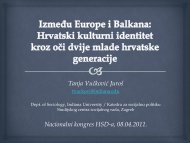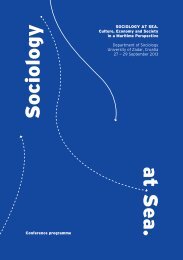rujan 2011. - Hrvatsko sociološko društvo
rujan 2011. - Hrvatsko sociološko društvo
rujan 2011. - Hrvatsko sociološko društvo
You also want an ePaper? Increase the reach of your titles
YUMPU automatically turns print PDFs into web optimized ePapers that Google loves.
LISTOPAD 2011 BROJ 1/2011<br />
WWW.HSD.HR<br />
Međunarodne akademske publikacije<br />
članova HSD-a<br />
Razdoblje objavljivanja: siječanj - <strong>rujan</strong> <strong>2011.</strong><br />
SADRŽAJ:<br />
Članci u inozemnim časopisima ..............................1 - 6<br />
Poglavlja u knjigama inozemnih izdavača ..............7 - 10<br />
Strani autori o <strong>Hrvatsko</strong>j (izbor) ............. ................11<br />
Članci objavljeni u inozemnim časopisima.<br />
‣ Babarović, Toni; Čilić Burušić, Lidija; Burušić, Josip."Who are the Supporters of Croatian<br />
Membership in the European Union and NATO? – Predictive Value of Personal and National Well-<br />
Being." Social Indicators Research. 102 (2011) , 1; 71-80<br />
http://www.springerlink.com/content/p471205425402605/<br />
Sažetak: Like many other Central and Eastern European countries Croatia has passed through<br />
substantial political changes and transition processes from state to liberal market economy in the last two<br />
decades. The next important step is accession to EU and NATO, and public opinion about joining these<br />
associations is divided. The aim of this study is to investigate the predictive value of subjective wellbeing<br />
measures in explaining attitudes of Croatian citizens toward accession to NATO and European<br />
Union. In particular, the prognostic utility of SWB is tested over and above usefulness of basic sociodemographic<br />
variables in explaining those political opinions. The research was conducted on a huge and<br />
representative sample (N=4000) of Croatian citizens in the spring of 2009. As a measure of subjective<br />
well-being, Croatian version of International Well-Being Index (IWI ; Cummins, 2002) was used. IWI<br />
includes National and Personal Well-Being scales where each scale consists of several personal or<br />
national well-being domains. Socio-demographic variables used in this survey were gender, age, and<br />
level of education. Hierarchical logistic regression was applied to test the unique contribution of National<br />
and Personal well-being domains in predicting attitudes toward accession. The results show that National<br />
well-being index is useful in predicting attitudes toward accession of Croatia to EU and NATO, and has<br />
an even higher predictive value than basic socio-demographic variables. National well-being domains<br />
that significantly improve prediction were satisfaction with government and satisfaction with national<br />
economic situation. Higher satisfaction with national government is related to support of accession to<br />
both alliances, whereas higher satisfaction with national economy is associated solely with supporting<br />
the EU membership. The personal well-being index and belonging domains were not useful in this<br />
political attitude prediction. Possible theoretical explanation of observed relations between NWI and<br />
political opinion were further discussed.
‣ Josipovic-Jelic, Z., Sonicki, Z., Soljan, I., Demarin, V. and the Collaborative Group for Study of Epilepsy<br />
Epidemiology in Sibenik–Knin County, Croatia (2011). "Prevalence and socioeconomic aspects of epilepsy<br />
in the Croatian county of Sibenik–Knin: Community-based survey", Epilepsy and Behavior; 20: 686–690.<br />
http://www.sciencedirect.com/science/article/pii/S1525505011000643<br />
Sažetak. The aim of the survey was to estimate the prevalence rate of epilepsy, as well as seizure types, frequency,<br />
etiology, and comorbidity, by gender, age, and socioeconomic status among people with epilepsy in the Croatian<br />
county of Sibenik-Knin. The survey revealed that of 112,871 inhabitants, 1228 were identified as having active<br />
epilepsy. The crude prevalence rate for Sibenik-Knin County was 10.9 per 1000 inhabitants. Prevalence rates (per<br />
1000) by age and gender were: 6.9 (ages 0-19); 10.6 (ages 20-59); 15.1 (ages 60+), 10.1 (females), and 11.7 (males).<br />
A significant number of subjects had different comorbid disorders. Although the literature suggests that Dalmatia is<br />
a region with a low prevalence of epilepsy, our results showed that Sibenik-Knin County has a higher prevalence of<br />
epilepsy than expected for European populations. The most common comorbid disorders, such as mental retardation,<br />
psychotic episodes, and substance addiction, highly influence socioeconomic status and quality of life.<br />
‣ Kang, C. Handy, F., Hustinx, L., Cnaan, R., Brudney, J., L., Haski-Leventhal, D., Holmes, K., Meijs, L.,<br />
Pessi, A., B., Ranade, B., Smith, K., Yamauchi, N., Zrinščak, S. (<strong>2011.</strong>) What gives? Cross-national<br />
differences in students' giving behavior. The Social Science Journal, 48(2): 283-294.<br />
http://www.sciencedirect.com/science/article/pii/S0362331911000024<br />
Sažetak: This study is targeted to understanding the giving of time and money among a specific cohort – university<br />
students across 13 countries. It explores predictors of different combinations of giving behaviors: only volunteering,<br />
only donating, neither, as compared to doing both. Among the predictors of these four types of giving behavior, we<br />
also account for cross-national differences across models of civil society. The findings show that students<br />
predominantly prefer to give money than to volunteer time. In addition, differences in civil society regimes provide<br />
insights into which type of giving behavior might dominate. As expected, in the Statist and Traditional models of<br />
civil society, students consistently were more likely to be disengaged in giving behaviors (neither volunteering nor<br />
giving money) in comparison to students in the Liberal model who were more likely to report doing ‘both’ giving<br />
behaviors. An important implication of our findings is that while individual characteristics and values influence<br />
giving of time and money, these factors are played out in the context of civil society regimes, whose effects cannot<br />
be ignored. Our analysis has made a start in a new area of inquiry attempting to explain different giving behaviors<br />
using micro and macro level factors and raises several implications for future research.<br />
‣ Lažnjak, J., Šporer, Ž., Švarc, J. "Women in Science Commercialization: Looking for Gender<br />
Differences". Gender Technology and Development. 15 (2011) , 2; 175-200<br />
http://gtd.sagepub.com/content/current<br />
Sažetak: This article analyzes the participation of women in technology-oriented scientific projects (known as the<br />
TEST program) to identify gender-based differences in attitudes toward commercialization and innovation based on<br />
scientific research. The analysis is based on the TEST program that marks a milestone in science policy in Croatia,<br />
and represents a shift toward innovation policy. There is a higher representation of women project leaders in the<br />
TEST program than in the standard scientific projects. Our research started with the hypothesis that the higher proportion<br />
of women scientists in technology projects is related to gender differences in sociodemographic<br />
characteristics, in the motivation for application as well as implementation of the projects, and satisfaction with the<br />
results of the TEST program. The results confirmed gender differences only in scientific field, previous career<br />
positions, and num-ber of scientific publications, and do not offer an explanation of the relatively higher proportion<br />
of women researchers in TEST program. The findings indicate that once women scientists have an equal chance for<br />
commercialization, they perform as well as men do.
‣ Petričušić, A. (2011). "Ethno-Mobilisation and its Consequences in Croatia", Southeastern Europe 35, 1;<br />
39-61<br />
423250.JSEE_Petricusic.pdf<br />
Sažetak: The paper pursues the explanation that political leaders in Croatia and Serbia at the beginning of 1990s<br />
used different and sometimes conflicting historical narratives of the two biggest ethnic groups in Croatia (Croats and<br />
Serbs), manipulating those conflicting narratives and constructing nationalistic discourse in order to (re)-assure their<br />
power position. At the outset, the paper attempts to explain the term ethno-mobilisation. In the following part the<br />
paper deals with the actors and means of ethno-mobilisation that was taking place in Croatia. In the third part the<br />
paper elaborates on the consequences of such ethno-mobilization policies. The paper finally underlines that in spite<br />
of the quite advanced minority legislation that emerged in early 1990s, realization of the rights of minorities,<br />
particularly Serbs, was often hindered by unjust bureaucratic processes and the absence of political will.<br />
‣ Peračković, K. (2011). "Division of Labour in some Classical Concepts - An Attempt of Contemporary<br />
Theoretical Synthesis." Journal des Economistes et des Etudes Humaines. 17, 1; 1-17<br />
http://www.bepress.com/jeeh/vol17/iss1/art1/?sending=11403<br />
Sažetak: This paper analyzes classical concepts of division of labour and offers some contemporary theoretical<br />
model which includes causes and effects of it. For Smith, the main cause is a tendency of human nature to exchange<br />
and the main effect is a progress of the country. For Marx, the fundamental cause is historical development of<br />
productive forces and effects are accumulation of capital on the one side but also an alienation of working class on<br />
the other. Spencer considers as the main cause specialization of functions in generally, which consequence is<br />
integration of society. For Durkheim, causes are social density and volume, and its effect or function is new<br />
interconnection in society known as term organic solidarity. Weber derives division of labour from his theory of<br />
rational economic actions, and its most important effect is development of occupational structure.<br />
‣ Štulhofer, A., Kuljanić, K., Štulhofer, D. (2011). “Sexual health difficulties in a population-based sample<br />
of Croatian women aged 18-35 and the effects of the dual (career and motherhood) role”. Journal of Sexual<br />
Medicine, 8: 1314-1321.<br />
http://onlinelibrary.wiley.com/doi/10.1111/j.1743-6109.2010.02100.x/full<br />
Sažetak: Introduction. The prevalence of sexual health disturbances among women in Croatia is presently unknown.<br />
Although women under 40 years of age are often exposed to the most intense demands of the dual role (career and<br />
motherhood), they are frequently assumed to be at lower risk for sexual difficulties. Aim. To assess the prevalence<br />
of sexual disorders in a population-based study of women aged 18-35 and to explore the possible impact of the dual<br />
role on female sexual health. Methods. The study was carried out in April 2010 on a multi-stage probability sample<br />
(N=1, 000) of women aged 18-35 years. The response rate was 33 percent. Multivariate logistic regression was used<br />
to analyze the correlates of sexual difficulties, including the dual role. Main Outcome Measures. The prevalence of<br />
the four most common female sexual health difficulties (lack of desire, lubrication difficulties, inability to reach<br />
orgasm, and pain during intercourse) were measured using the indicators from the Global Study of Sexual Attitudes<br />
and Behaviors. Participants were asked if they experienced any of the four difficulties in the preceding year and<br />
were instructed to report only those that lasted for at least two months. Results. Among coitally experienced women<br />
(N=870), 27.6% reported having a lack of desire, 23.6% pain during sexual intercourse, 23.1% inability to reach<br />
orgasm, and 18.5% difficulties with genital lubrication. All four disturbances were negatively associated with sexual<br />
satisfaction, but only the lack of sexual interest and inability to reach orgasm seemed to substantially decrease<br />
sexual well-being. In multivariate analyses, age, education, being in a steady relationship or married, and partner<br />
communication about sexuality were significant correlates of reported sexual difficulties. The dual role was not a<br />
significant predictor of sexual health disturbances. Conclusions. A substantial proportion of participants reported<br />
one or more sexual health difficulties. Contrary to expectations, women in the dual role were not at an increased risk<br />
of sexual health disturbances.
‣ Štulhofer, A. and Baćak, V. (2011). Is anal sex a marker for sexual risk taking? Results from a populationbased<br />
study of young Croatian adults. Sexual Health, 8(3): 384-389.<br />
http://apps.webofknowledge.com/full_record.do?product=WOS&search_mode=GeneralSearch&qid=4&SID=X1oF<br />
PApM7bBAcPio19I&page=2&doc=16&cacheurlFromRightClick=no<br />
Sažetak: There is evidence that anal sex is becoming increasingly popular among heterosexual women<br />
and men. A number of studies carried out in especially vulnerable populations (“high-risk groups”)<br />
suggested that anal sex may indicate a more general propensity to sexual risk taking. To assess whether<br />
this epidemiologically important finding holds in the case of young adults from the general population,<br />
we analyzed from a national probability study carried out in 2010 on 861 sexually experienced Croatian<br />
women and men aged 18-25. Anal intercourse was reported by 36.5% of participants. About one third of<br />
them (34%) used a condom at most recent anal intercourse. The experience of anal sex was significantly<br />
associated with all four indicators of sexual risk taking (condom use at most recent vaginal intercourse,<br />
number of sexual partners in the past year, concurrent sexual relationship, and anonymous sex in the past<br />
year), as well as with negative attitudes and beliefs about condom use. Sexual sensation seeking mediated<br />
the relationship between anal sex and some of the sexual risk-taking behaviors. According to the<br />
findings, heterosexual anal sex is directly and indirectly associated with increased behavioral risks of<br />
acquiring HIV and other STI. Sex education and HIV/STI prevention programs should focus on the<br />
importance of using protection when practicing anal sex.<br />
‣ Štulhofer, A., Ajduković, D (2011) “Should we take anodyspareunia seriously? A descriptive analysis of<br />
pain during receptive anal intercourse among young heterosexual women”. Journal of Sex and Marital<br />
Therapy, 37:346–358.<br />
http://bib.irb.hr/datoteka/529996.Anodyspareunia_JSMT_<strong>2011.</strong>pdf<br />
Sažetak: Anal sex is becoming increasingly prevalent among heterosexual women and men.<br />
Although pain related to receptive anal intercouse is not uncommon, little is known about its<br />
phenomenology. The article aims to assess the prevalence and correlates of pain during<br />
anoreceptive intercourse, including anodyspareunia, its most severe form, among young women. An<br />
online survey focusing on anal eroticism was carried out in March and April 2010 on a convenience<br />
sample of 2, 002 women 18-30 years of age. Participants who reported 2 or more episodes of anal<br />
intercourse in the past years were asked about the level and frequency of pain at anoreceptive<br />
penetration ; those who reported unbearable (too painful to continue) or strong pain at every such<br />
occasion were classified as anodyspareunic. The experience of anal intercouse was reported by<br />
63.2% (n=1, 265) of participants. Although almost half (48.8%) had to discontinue their first<br />
anoreceptive intercourse because of pain or discomfort, a majority of women (62.3% ; n=788)<br />
continued anal sex. Of the 505 participants who reported 2 or more episodes of anal intercourse in<br />
the past year, the women (8.7% ; n=44) who reported severe pain during every anoreceptive<br />
penetration were classified as non-anodyspareunic. For more than two thirds of women with<br />
anodyspareunia, the current pain level remained unchanged from their first experience with anal<br />
sex. Inability to relax was the most frequent self-hypothesized cause of pain among the<br />
anodyspareunic and nonanodyspareunic groups. Compared with other women, those with<br />
anodyspareunia reported substantially lower levels of sexual satisfaction (odds ratio=.95 ; p
‣ Štulhofer, A., Buško, V., Schmidt, G. (2011). “Adolescent exposure to pornography and relationship<br />
intimacy in young adulthood”. Psychology and Sexuality, DOI: 10.1080/19419899.2010.537367.<br />
http://www.tandfonline.com/doi/abs/10.1080/19419899.2010.537367<br />
Sažetak: The hypothesis that exposure to pornography during adolescence leads to reduced intimacy among young<br />
adults was tested using a sample of 544 Croatian college students (aged 18-25) who were surveyed online.<br />
Respondents provided information about pornography use at ages 14 and 17, the realism of pornographic depictions<br />
of sexual activities, attitudes toward recreational sex, and relationship intimacy. Significant gender differences in<br />
pornography exposure, perceived realism of pornographic contents, and attitudes toward recreational sex were<br />
found. Structural equation analyses suggested that the effect of pornography on relationship intimacy, may be<br />
mediated by the acceptance of recreational sex, and is more related to the perception of pornographic realism than to<br />
actual exposure to explicit sexual materials. Interestingly, the associations were significant only for female<br />
participants. However, as the final model accounted for 14-16 percent of variance in reported relationship intimacy,<br />
phenomena other than pornography are by far more substantial determinants of intimacy that young Croatian<br />
women achieve in their romantic relationships.<br />
‣ Štulhofer, A., Šoh, D., Jelaska, N., Baćak¸ V., and Landripet, I. (2011). Religiosity and sexual risk behavior<br />
among Croatian college students, 1998-2008. Journal of Sex Research, 48(4): 360–371.<br />
http://www.tandfonline.com/doi/abs/10.1080/00224499.2010.494257<br />
Sažetak: Substantial increase in religious identification was observed in most European post-communist countries.<br />
As religiosity has been associated with STI/HIV vulnerability among young people, this paper examined the impact<br />
of religious upbringing and personal religiosity (religiousness) on sexual risks among the University of Zagreb firstyear<br />
undergraduate students using data collected in 1998, 2003, and 2008. Female participants who reported strict<br />
religious upbringing were less knowledgeable about human sexuality than other women. Religiousness was<br />
negatively correlated with basic knowledge of human sexuality, but again only among women. Contrary to<br />
expectations, no significant associations were found between religious upbringing or religiousness and condom use.<br />
Both measures of religiosity, however, were related to the decreased odds of sexual debut among young women. In<br />
the case of male participants, the impact of religiosity was marginal. Religious upbringing was associated<br />
(negatively) with sexual literacy and sexual debut – but only at the beginning of the observed period. Overall,<br />
religiosity does not seem to substantially reduce STI/HIV-related risk taking, particularly among men. Since the<br />
observed increase in the proportion of sexually active students during the 1998-2008 period was not matched by an<br />
increase in condom use, reducing STI/HIV vulnerability among Croatian youth remains an essential task.<br />
‣ Švab, A., Štulhofer, A., Bernik, I., Landripet, I., Kuhar, R, Baćak, V. (2011). “Research on young people’s<br />
sexuality in Croatia and Slovenia, 1971-2008: A systematic overview” /with/. Annales, 21, 137-152.<br />
http://apps.webofknowledge.com/full_record.do?product=WOS&search_mode=GeneralSearch&qid=3&SID=X1oF<br />
PApM7bBAcPio19I&page=1&doc=6&cacheurlFromRightClick=no<br />
Sažetak: A systematic overview of research on youth sexuality and its main findings in Croatia and Slovenia during<br />
the period 1971-2008 is presented. The aim was to analyze the development of a particular type of research in the<br />
two countries characterized by an absence of sexological tradition. Research studies from four decades are<br />
contextualized – taking into account specific socio-historic and ideological underpinnings – and critically assessed.<br />
Between-country similarities and differences are discussed, as well as theoretical shortcomings and methodological<br />
limitations of the reviewed research studies. This brief history of research on young people’s sexuality in Croatia<br />
and Slovenia highlights the role of international dissemination of ideas and knowledge, particularly in the context of<br />
peripheral research communities. Due to professional divisions, financial restrictions, and the absence of ties to<br />
public health and educational policies, difficulties facing interdisciplinary research on human sexuality – the subject<br />
still perceived as either trivial or controversial – seem to continue in the post-transitional period.
‣ Švarc, J., Lažnjak, J., Perković, J."Unintended consequences of the innovation policy programmes: social<br />
evaluation of the Technological Projects programme in Croatia". Innovation: Management, Policy &<br />
Practice. 13 (2011) , 1; 77-94<br />
www.innovation-enterprise.com/archives/vol/13/issue/1/<br />
Sažetak: The paper presents empirical results of social evaluation of the first innovation policy programme,<br />
Technology Projects (TEST), in Croatia to identify and explain the main bottlenecks of the programme and put them<br />
in perspective in terms of the entire innovation system. The motivation is the growing criticism of innovation<br />
system's efficiency and perception of poor return on public investment in innovation policy programmes. The<br />
proposed method of social evaluation is based on combination of the institutional theory and the sociological<br />
approach of intended and unintended consequences. It reveals that expected outcomes of the programme such as<br />
commercialisation of research and technological outputs are exchanged, in the majority of projects, for essentially<br />
scientific results such as scientific publications and extension of the on-going scientific projects. The reasons are<br />
found in the institutional deficits that point to the persistence of some common 'systemic' problems in the innovation<br />
system. Their drivers are identified in three types of institutional deficits: administrative rules and procedures, some<br />
aspects of social capital and broader socio-economic environment that commonly determine behaviour and<br />
interaction of the main stakeholders of the programme.<br />
‣ Traen, B., Štulhofer, A. (2011). "Self-assessed risk of HIV and other STIs among young adults in Norway<br />
and Croatia". Sexuality and Culture, DOI:10.1007/s12119-011-9098-x<br />
http://www.springerlink.com/content/0tq50u618737m186/<br />
Sažetak: The purpose of the present study is to explore how sexually active young Norwegian and Croatian adults<br />
assess the risk of being infected with HIV and other STIs. Study results are based on a 2009–2010 large-scale<br />
national probability survey of young adults aged 18–24 in Croatia (n = 1,005) and Norway (n = 871). A majority of<br />
sexually active young adults in Croatia and Norway assessed the risk of becoming infected with HIV or other STIs<br />
as low or negligible. Among non-condom users, 85–98% determined they had low or no risk of getting infected with<br />
HIV. The corresponding figures for STIs were 77–79%. In both countries a higher HIV risk self-assessment was<br />
observed among those who had had same-sex sexual experience, those who reported a higher number of sex partners<br />
during the past year, and those who were single. When investigating the patterns of HIV/STI risk assessment, gender<br />
and country-related differences appeared. Condom use associated with higher risk assessment was significant only<br />
among Croatian men. The strong perception of condom use as being a male responsibility in Croatia may be the<br />
reason for a higher risk assessment for unwanted pregnancy and HIV/STIs when protection fails. The risk<br />
assessment for HIV/STIs was not associated with partner turnover in Croatian men. New campaigns need to develop<br />
gender-sensitive messages, particularly targeting men who believe that a great number of sexual partners is a sign of<br />
manliness and women who shy away from their responsibility to use protection.<br />
‣ Topić, M. "Nations and Nationalism: Questioning Ernest Gellner’s Theory." Intersticios. Revista<br />
sociológica de pensamiento crítico. 5 (2011)<br />
http://www.intersticios.es/article/download/7261/5746<br />
Sažetak: The question of nations and nationalism always brings a lot of question for there does not seem to be an<br />
agreement on the roots of nationalism and the typology it brings with. The disagreement on nation and national goes<br />
that far that, there is no agreement on who used the term nationalism first and let alone on actual applicability and<br />
consequences it goes with. Ernest Gellner, as an author of one, largely discussed, theory, sees nations as bi-products<br />
of industrialization and as made up where they did not exist before. In this sense, he identifies three periods of<br />
human lives: hunter-gatherer (or, pre-agrarian), agro-literate and industrial and sees nationalism as an existing<br />
movement only in the third one. In this sense, he ties nationalism with imperialism for he claims that nationalism<br />
always seeks to spread the boarders and for the higher class to control the lower class. Also, he sees impossible for<br />
pre-industrial societies to be able to foster nation and nationalism as such since, for him, nations do not exist where<br />
there is no state. This paper therefore discusses this theory based on other theories of nationalism that offered<br />
different views (namely Benedict Anderson’s and Anthony D. Smith’s theories) as well as some examples of<br />
nationalistic movements from Spain and Croatia. The issues questioned in this paper are thus Gellner’s view of<br />
nationalism emerging after industrialization, non-existence of nationalism without the state ; the system of the state<br />
education as a means of enforcing nationalism and cultural and national homogeneity.
Poglavlja objavljena u knjigama inozemnih izdavača.<br />
‣ Adamović, M. i Mežnarić, S. Women and cultural management in a patriarchal society, u<br />
Belayev, D. and Roca, Z. (2011) Contemporary Croatia: Development Challenges in a Socio-Cultural Perspective.<br />
Lisbon: Edicoes Universitarias Lusofonas, s. 137-174.<br />
Sažetak: As far as women's rights are concerned, Croatia, like other countries in Central and Eastern Europe,<br />
inherited a specific form of protection of women’s rights from the socialist period. The socialist ideology helped<br />
women move into many professions, although in that period and later, in the post‐socialist period, the wage gap<br />
widened. In the latter period, a re‐traditionalisation of society took place, the political elite embraced traditional<br />
values (motherhood became part of the militaristic discourse of the state), which, alongside the circumstances of<br />
war, resulted in the economic, political and cultural neglect of women. Changes in the educational system, the<br />
higher proportion of female graduates in the population of graduates in general, have not had any major<br />
repercussions in terms of changes to the composition of the management elite. Women in Croatia are<br />
underrepresented in management and decision‐making positions. It may be said that younger women are reaping the<br />
fruits of socialism, which offered them greater access to education, and the influence of a previous value system<br />
aiming more at full employment and equality than the present one, in the post‐socialism period.<br />
‣ Čengić, Drago.Habitus, Market and Kutjevo Wine-makers: A Case Study // Economy in Changing<br />
Society: Consumption, Markets, Organizations and Social Policies / Maria Nawojczyk (ur.).Newcastle<br />
upon Tyne, Velika Britanija : Cambridge Scholars Publishing, <strong>2011.</strong>. Str. 153-172.<br />
Sažetak: Suprotno prevladavajućim raspravama u ekonomskoj sociologiji i dijelu ekonomske teorije, u ovome radu<br />
htjeli smo pokazati (uz pomoć dinamičkoga koncepta tržišta i Bourdieuova poimanja habitusa i 'ekonomskoga<br />
polja') da je izgradnja tržišnih sudionika u post-socijalističkome kapitalizmu jedan složen proces, koji zatjeva duže<br />
vremensko razdoblje. Na primjeru kutjevačko-požeških vinara kao poduzetnika prve generacije u Požeštini pokazuje<br />
se da „proizvodnja i ‘samoproizvodnja’ poduzetnika“ poduzetnika podrazumijeva kompleksno i ekonomsko i<br />
društveno ponašanje svih uključenih sudionika: od lokalne države, samih vinara do središnje države i drugih<br />
relevatnih sudionika. U radu se posebno razvijene sljedeće teme: tržište, tržišni sudionik i logika njegova ponašanja ;<br />
'predtržišni habitus', transformacija u poduzetnike-početnike i tržišno ponašanje ; ekonomski interesi i politika<br />
djelovanja u lokalnoj zajednici ; kultura, habitus i pitanje suradnje ; ekonomsko polje, međunarodne integracije i<br />
vrijeme kao razvojni resurs. Po nama, tržišna budućnost kutjevačko-požeških vinara ovisi ipak ponajviše od njihova<br />
ekonomskoga rasta, kakvoće njihova vina i međusobne suradnje kroz nove/više oblike međusobnoga umrežavanja i<br />
(samo)organiziranja.<br />
‣ Katunarić, V. Causes of parochial status in international knowledge production. In: Demyan Belyaev and<br />
Zoran Roca, edited by: Contemporary Croatia: Developmental Challenges in a Socio-Cultural Perspective.<br />
Lisboa: Edições Universitárias Lusófonas, <strong>2011.</strong>,101-132.<br />
Sažetak: Causes of parochial status of Croatia in international knowledge production are analyzed from two<br />
different perspectives. Each one is represented through works of different authors, scientific and other who wrote on<br />
the topic. First perspective is technocratic and it regards knowledge as a new source of economic development. The<br />
most popular notion in this perspective is “knowledge societies”. A bulk of scientific mainstream in Croatia shares<br />
this perspective. Author puts forward advantages and disadvantages of the technocratic position as regards its<br />
explanations of the Croatian lagging in the international production of knowledge. Author applies an analogous<br />
approach with regard to the second perspective, i.e. the postcolonial theory which proclaims the “knowledge<br />
society” being a new mode of the Western cultural imperialism. In conclusion author reflects about possibilities of<br />
creating an egalitarian knowledge society. He attempts to identify such possibilities through analyzing types of<br />
knowledge generated through cooperative work – first of all, knowledge needed for large-scale employment. To this<br />
purpose, he discusses about possibilities of retesting and renewal of some old occurrences of holistic knowledge
‣ Leburić, A. (2011) Edukacijski aspekti medija kao oblikovatelja svjetonazora. (Co-author with Z. Š. Vučica<br />
and J. Bajić). U Kpeatибністъ уҹителя в інноваційній школі. Бочарова О. А., Аксман Дж. (eds).<br />
Str.191-202. Горлівка, Ukraїna: Miнictepctbo ocbitи i нaүkи Уkpaїни; Гopлibcбkий Дepжabний<br />
пeдaгoгiчний iнctиtуt iнoземниx мoв; Krakowska akademia im. A.F.Modrzewskiego. (ISBN: 978-966-<br />
8469-92-3)<br />
Sažetak: U kontekstu rasprave o ulozi medija u društvu, autorice ističu da informacijske i komunikacijske<br />
tehnologije omogućavaju unaprjeđivanje komuniciranja, ali i prijenos još bogatijih informacija. Pri tome smatraju da<br />
je medij jedinstvo sredstva i komunikacije. Polazeći od shvaćanja medija kao oblikovatelja čovjekovog svjetonazora<br />
procijenile su neophodnim i značajnim empirijski istražiti kako se jezično oblikuju sadržaji, poruke i informacije u<br />
medijima, te kako oni povratno utječu na interakciju i komunikaciju između publike i medija. Stoga su realizirale<br />
sociološko empirijsko istraživanje čiji je temeljni (opći) istraživački cilj bio analizirati što se događa u pojedinim<br />
medijima (tiskanim i elektroničkim) u <strong>Hrvatsko</strong>j, s obzirom na upotrebu jezika, kao i s obzirom na društvenu<br />
kontekstualizaciju te medijske upotrebe, odnosno relevantne konstrukcije medijske/-ih stvarnosti. Sukladno tome,<br />
analiziraju se sadržaji, gledanost, slušanost i čitanost pojedinih medija s obzirom na odnose privatno-nacionalno i<br />
državno-lokalno, te se u tom kontekstu razmatraju i edukacijski aspekti medija. Konačno, konstatira se da je<br />
primarna zadaća medija potencijalnim gledateljima, slušateljima i čitateljima ponuditi što opširniju i raznolikiju<br />
ponudu informacija, a sve to s najvećom mogućom objektivnošću. Nadalje, ističe se nužnost društveno prihvatljivog<br />
afirmiranja i iskorištavanja medijskih sadržaja u pozitivne svrhe.<br />
‣ Leburić, A. (2011) The Gifted in the Educational System of Croatia. (Co-author with M. Ljubetić and Z. Š.<br />
Vučica) In Educational Studies and School. Kahn, R.; Mazur, S. (eds.) Pg. 175-186. Los Angeles, USA:<br />
Antioch University Los Angeles, Department of Education. (ISBN: 978-1-4507-7293-8)<br />
Sažetak: The authors start from the consideration of giftedness as a complex social phenomenon. Specifically, the<br />
contextualization of gifted children /students, of their overall social, cognitive and emotional development is the<br />
result of everything that is happening in society and is placed within their subjectivised everyday life. Therefore, a<br />
socio-pedagogical research and interdisciplinary survey were conducted in spring 2009. A research sample was<br />
structured into two main categories, with preschool educators and with teachers who were at that time employed in<br />
Split elementary schools. The objectives of the research included the examination of the respondents' attitudes and<br />
opinions about the characteristics of gifted children /students, as well as perspectives for the development of their<br />
giftedness, as well as their socialization in general. Research results confirmed that the gifted children in each<br />
segment are perceived as ''different''. Parents have a key role, besides the experts in educational institutions, in the<br />
socialization process of their children. The entire educational system does not develop a favourable climate for their<br />
development which often leads to frustration of gifted children. In this context the authors emphasize that social care<br />
for such children should be build on the foundations of knowledge and responsibility with a lot of positive energy,<br />
optimism and enthusiasm. Therefore, the training of experts in institutions becomes necessary, as well as their<br />
stronger and intensive interaction and collaboration with parents.<br />
‣ Leburić, A. (2011) The Impact of Information Technology in Education: Communications on Blogs and<br />
Forum. (Co-author with M. Lončar and M. Dadić) In Democratic Access to Education. Kahn, R.;<br />
McDermott; Akimjak, A. (eds.) Pg.235-244. Los Angeles, USA: Antioch University Los Angeles,<br />
Department of Education. (ISBN: 978-1-4507-7292-1)<br />
Sažetak: Human communication as the core for the establishment of community and sociability, has undergone<br />
revolutionary changes that led to the use of new techniques of communication. That is why it became an interesting<br />
sociological research subject. Without information technology, many interactions between people would be<br />
disabled. It is necessary to understand that modern society does not give up school, but its traditional character.<br />
School should be gradually changed through transformation of teaching methods in the process of creative and<br />
innovative learning. In other words, information technology offers countless possibilities. Therefore, a discursive<br />
analysis of new media, namely communication in blogs and forums new forms of communication of young people<br />
and their impact on the educational process was carried out at the Department of Sociology in Split.
‣ Leburić, A. (2011) Utjecaji školovanja na društveno ponašanje mladih. (Co-author with J. Bajić). U<br />
Учитель, школа й освіта. Кожух, Б.; Бочарова, О. А. (eds). Str.93-104. Горлівка, Ukraїna: Miнictepctbo<br />
ocbitи i нaүkи Уkpaїни; Горлівський державний педагогічний інститут іноземних мов; Krakowska<br />
akademia im. A.F.Modrzewskiego; Univerza na Primorskem. (ISBN: 978-966-8469-0)<br />
Sažetak: Zbog niza zajedničkih obilježja, mladi pripadaju posebnoj društvenoj skupini, ali su unutar sebe raslojeni<br />
sukladno diferencijaciji hrvatskoga društva. Budući da je Hrvatska jedna od zemalja u razvoju, mlade naročito<br />
pogađa društveno raslojavanje, egzistencijalna neizvjesnost, te upitno ostvarenje osobnih životnih ciljeva. To je<br />
povezano s (ne)dostupnošću obrazovnih institucija i programa u situaciji kada primjereno obrazovanje osigurava<br />
društvenu promociju i povećava sposobnost konkuriranja na tržištu rada u novim, kompeticijskim uvjetima. Mladi<br />
usporeno ulaze u svijet odraslih zbog dužeg trajanja institucionaliziranog obrazovanja, otežanog zapošljavanja i<br />
prolongiranja zasnivanja vlastite obitelji. Budući da ne postižu samo¬ostvarenje, postaju marginalizirani što<br />
potencijalno može voditi ka sve većem stupnju nezadovoljstva i nesigurnosti. Iako proces globalizacije nudi<br />
nebrojene mogućnosti, ipak on u sebi nosi određenu dozu rizika kojem su ponajviše izloženi mladi kao najranjivija<br />
društvena skupina. Razumno je složiti se sa tvrdnjom da mladi danas žive u obiteljima srednje prosječne kvalitete<br />
življenja u odnosu na mogućnosti obrazovanja, zdravstvene usluge, posjedovanje nekretnina i pokretnina, kupovinu,<br />
ostvarivanje kulturnih aspekata svoga života i slično, dok je ipak za očekivati najmanji broj onih koji žive<br />
najsiromašnije i najbogatije. Mladima se u suvremenom društvu, pa tako i u <strong>Hrvatsko</strong>j, pristupa dvojako: kao izvoru<br />
društvene dobrobiti i kao društvenom problemu, pa se u skladu s tim koncipiraju i nacionalne politike prema<br />
mladima. Cilj društvene intervencije (djelovanja) jest da se, izlazeći ususret i potrebama mladih i potrebama društva,<br />
osiguraju uvjeti za optimalno iskazivanje sposobnosti i inovativnih potencijala mladih na ekonomskom, društvenom,<br />
kulturnom i političkom području, te njihova odgovarajuća integracija u postojeće društvo. U kontekstu aktualnog<br />
uključivanja Hrvatske u proces europske integracije, osposobljenost, informiranost i sudjelovanje mladih može<br />
pridonijeti boljem i bržem odvijanju toga procesa, jer promicanje pridruživanja Hrvatske Europskoj uniji najveću<br />
potporu uživa upravo među mladima (Nacionalna konferencija: Mladi i društvo u tranziciji, 51-52). Tako mladi<br />
pokazuju najviše interesa na području individualnog napredovanja i građenja osobnog uspjeha, te vide EU kao<br />
plodno tlo za postizanje uspjeha u različitim područjima društvenoga djelovanja. Smanjenjem važnosti nacionalnih<br />
granica, jačanjem sveopće komunikacije otvaraju se nebrojene mogućnosti ulaska u europsku dimenziju koja je<br />
mladim ljudima nadasve atraktivan društveni prostor. Budućnost će pokazati koliko je entuzijazam mladih<br />
zadovoljen. Mladi predstavljaju ogroman potencijal u kontekstu razvoja modernoga, demokratskoga i ljudskim<br />
pravima usmjerenoga društva i uvelike žele prihvatiti odgovornost koja im pripada. Isto tako, mladi žele aktivno<br />
sudjelovati u kreiranju društva, bilo na lokalnoj ili na globalnoj razini, a sve u skladu s normama i vrijednostima<br />
putem kojih je to društvo uređeno. Zato je važno mladima omogućiti članstvo u organizacijama koje formiraju<br />
zajednička stajališta i prijedloge, te ih upućuju ministarstvima. Primjerice, Vijeće Europe već više od trideset godina<br />
predstavlja jedinu međunarodnu organizaciju koja primjenjuje sustav zajedničke uprave na području politike za<br />
mlade. U tom sustavu struktura nadležna za donošenje odluka - Upravni odbor za mlade - svoj rad temelji na<br />
savjetovanju s predstavnicima organizacija mladih koje su okupljene u Savjetodavnom tijelu mladih. Konačno,<br />
upravo istraživanja društvenoga ponašanja mladih u Europi mogla bi ukazivati i dimenzionirati buduća realna<br />
društvena zbivanja, okolnosti i pretpostavke razvitku demokracije, uvažavanju ljudskih prava i sloboda i drugim<br />
civilizacijskim tekovinama.<br />
‣ Leburić, Anči (2011) Nove paradigme obrazovanja u budućim društvima znanja. (Co-author with M.<br />
Lončar and M. Dadić). U Šola in družba znanja. Kožuh, A.; Felda, D. (ured.) Str.163-170. Koper, Slovenia:<br />
Univerza na Primorskem, Pedagoška fakulteta Koper. (ISBN: 978-961-6528-95-5)<br />
Sažetak: Moguće je pretpostaviti nužnost promjena u obrazovnim procesima zbog stalnoga razvoja informacijskih i<br />
komunikacijskih tehnologija. Naime, integracijom elemenata i primjenom novih tehnologija u obrazovnim<br />
procesima Hrvatska može povećati njihovu djelotvornost i učinkovitost sukladno svojim potrebama. Ujedno tako,<br />
može omogućiti obrazovnim ustanovama stjecanje povoljnijega položaja (i njegovoga zadržavanja) na svjetskom<br />
tržištu. U društvu znanja obrazovanje neće biti samo sljedbenik društvenih i gospodarskih promjena, već će postati<br />
aktivni faktor svoga razvoja i to u okvirima novih obrazovnih procesa. Slažemo se da su informacijske i<br />
komunikacijske tehnologije nevjerojatno važne za budućnost svake zemlje, pa tako i za Hrvatsku. Stoga bi ulaganje<br />
u njihovu implementaciju trebalo biti na državnoj listi prioriteta. Primjena informacijsko-komunikacijskih<br />
tehnologija, te novih modela i metoda stjecanja znanja (po)ostajao bi tako svojevrstan izazov različitim sferama<br />
hrvatskoga društva i stručnjacima s različitih područja društvenih znanosti (pedagozima, sociolozima i dr.).
‣ Mežnarić, S. Migration in Croatia: What to Expect?u: Krasteva, A., Kasabova, A., Karabinova. D. (2010)<br />
Migrations from and to Southeastern Europe. Ravenna: Longo Editore Ravenna, s. 35-46 (knjiga izašla u<br />
siječnju 2011)<br />
Sažetak: Within the context of European regulation of migration and policies expected, what kind of strategies and<br />
goals Croatia has to design in order to mitigate the opening up of its (Eastern) borders. Demography and labor<br />
market policies, flexibility, were taken into account. Compared to migration policies of: Ireland, Australia, Slovenia.<br />
‣ Štulhofer, A., Buško, V., Brouillard, P. (2011). “The New Sexual Satisfaction Scale and its short form“ . In<br />
Fisher, T. D., Davis, C. M., Yarber, W. L., & Davis, S. L. /Eds./ Handbook of sexuality-related measures<br />
(3rd edition). New York: Routledge, pp. 530-532.<br />
Sažetak: Sexual satisfaction scale.<br />
‣ Štulhofer, A., Landripet, I. (2011). “Sexual Scripts Overlap Scale — short version“. In Fisher, T. D., Davis,<br />
C. M., Yarber, W. L., & Davis, S. L. /Eds./ Handbook of sexuality-related measures (3rd edition). New<br />
York: Routledge, pp. 604-605.<br />
Sažetak: Sexual scripts overlap scale.<br />
‣ Valenta, M., Mesić, M., Strabac, Z. Bosnian Croats in Croatia: 'Etnically Privileged Migrant, 'Culturaly<br />
Distant Co-ethnics' or 'Croats as any Other Croats'?' The Bosnian Diaspora, Integration in Transnational<br />
Communities / Valenta, Marko and Sabrina P. Ramet (ur.).<br />
Surrey : ASHGATE, <strong>2011.</strong> Str. 281-300.<br />
Sažetak: Based on previous studies on Bosnian refugees around the world, the authors assume, that unlike other<br />
migrants in Croatia, Bosnian Croats in Croatia may be seen as 'co-ethnic migrants' or 'ethnically privileged<br />
migrants'. However, it is also assumed that Bosnian Croats in Croatia are defined in two diametrically different ways<br />
- as lw status, culturally distant co-ethnics and as Croats as any other Croats, which has resulted in a different<br />
positioning toward the mainstream society.<br />
‣ Zrinščak, S. (2011) Local immigrant communities,welfare and culture: an integration / segregation<br />
dilemma. In: E. Carmel, A. Cerami and T. Papadopoulos (eds.) Migration and Welfare in the New Europe.<br />
Social Protection and the Challenges of Integration. University of Bristol, UK: The Policy Press, pp. 197-<br />
212.<br />
Sažetak: The chapter focuses on the role of migrant communities, ethnic as well as religious, while arguing that the<br />
social position of immigrants, and particularly their access to welfare rights, can not be adequately analyzed if not<br />
taking into account the general social positions and strategies of migrant ethnic and religious organizations. Based<br />
on the empirical research in twelve European countries the chapter investigates in more details the importance of<br />
families and migrant communities for the everyday life of immigrants, and the work of welfare networks that these<br />
communities organize for satisfying needs of their members: welfare, educational, religious, etc. It particularly<br />
stresses the importance of the concept of identities, the importance of religion, language, and families (nuclear and<br />
extended) for immigrants, but it also reflects the social debates and conflicts that are visible in many European<br />
societies nowadays. The chapter also questions the adequacy of the welfare state approach in researching the access<br />
of immigrant to different social rights.
Inozemni autori o <strong>Hrvatsko</strong>j (izbor)<br />
Belayev, D. and Roca, Z. (2011) Contemporary Croatia: Development Challenges in a Socio-Cultural Perspective.<br />
Lisbon: Edicoes Universitarias Lusofonas<br />
Rivera, L.A. (2011). "Impression Management of Stigmatized Nations." Pp. 114 - 138 in The Cultural Wealth of<br />
Nations, edited by N. Bandelj & F.F. Wherry. Standford University Press.<br />
• Ranija verzija ovog rada objavljena 2008. u American Sociological Review!<br />
Rivera, L.A. (2008). "Managing "Spoiled" National Identity: War, Tourism, and Memory in<br />
Croatia." American Sociological Review 73:613-634.


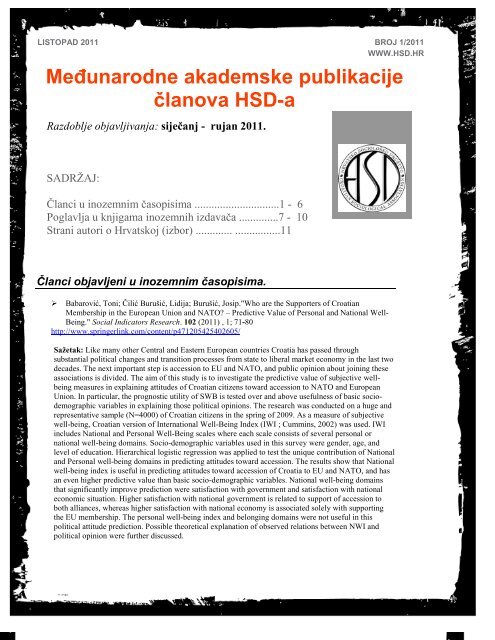
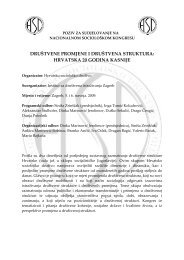

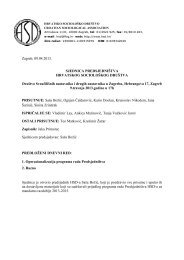
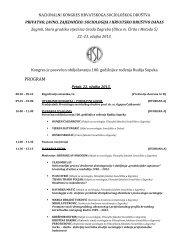
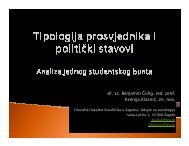
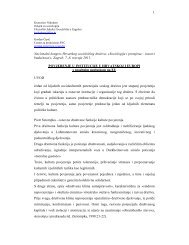
![PROGRAM SKUPA [pdf] - Hrvatsko sociološko društvo](https://img.yumpu.com/38770359/1/184x260/program-skupa-pdf-hrvatsko-socioloako-druatvo.jpg?quality=85)
